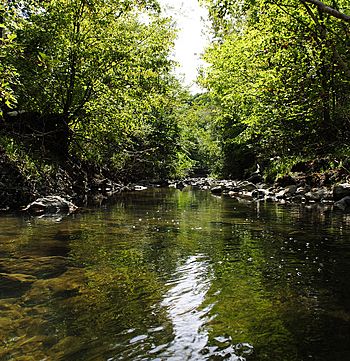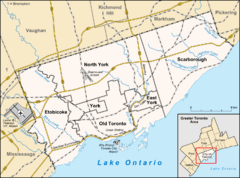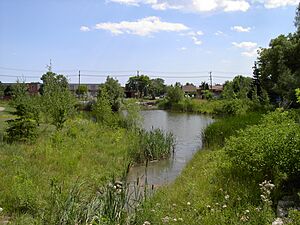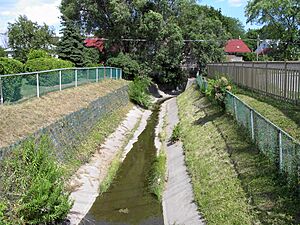Taylor-Massey Creek facts for kids
Quick facts for kids Taylor-Massey Creek |
|
|---|---|

Taylor-Massey Creek in Warden Woods Park, Scarborough
|
|
|
Location of the mouth of the creek in Toronto
|
|
| Country | Canada |
| Province | Ontario |
| Municipality | Toronto |
| Physical characteristics | |
| Main source | Culvert in Terraview Willowfield Park 169 m (554 ft) 43°46′00″N 79°18′47″W / 43.76667°N 79.31306°W |
| River mouth | Don River east branch 86 m (282 ft) 43°42′12″N 79°19′59″W / 43.70333°N 79.33306°W |
| Length | 16 km (9.9 mi) |
Taylor-Massey Creek is a small river, also called a tributary, that flows into the Don River in Toronto, Ontario. It travels through parts of Scarborough and East York before joining the Don River. Sometimes, people have called it Silver Creek or Scarboro Creek.
The creek gets its name from two important families in Toronto's history. The Taylors were a rich family who owned the Don Valley Brick Works, a big factory that made bricks. The Massey family owned a company called Massey-Harris, which made farm equipment. Both families had large properties near the creek. One historic building, the Massey Goulding Estate, was once part of the Massey family's land and is now used as the Children's Peace Theatre.
About Taylor-Massey Creek
Taylor-Massey Creek is about 16 kilometers (10 miles) long. A creek's headwaters are where it begins. This creek used to start near Sheppard and Victoria Park Avenues. However, when Highway 401 was made wider, the original starting point was changed. Now, the creek begins at a stormwater pipe just south of the highway.
The creek starts in Terraview Willowfield Park. This park is a special project to bring nature back to the area. The creek flows through two medium-sized ponds with natural channels. After that, it goes through concrete-lined channels and drains. This part of the creek runs along an old hydro path. Then, it enters an area with homes and factories that people cannot easily access.
South of Eglinton Avenue East, the creek flows through a shallow valley and passes by Pine Hills Cemetery. It then travels west and enters a small park on St. Clair Avenue East. At Warden Avenue, the creek turns southwest and goes through a park called Warden Woods. West of Pharmacy Avenue, it flows through a city golf course. Finally, at Victoria Park Avenue, it enters Taylor Creek Park and continues until it joins the Don River East Branch.
Challenges Facing the Creek
The area that drains into Taylor-Massey Creek is completely surrounded by city development. This has caused many problems for the creek. Much of the upper part of the creek is covered in concrete channels. This makes the water flow very fast and leaves little space for plants and animals to live. Other parts of the creek are held in place by rock-filled baskets called gabions.
The water in the creek is also very dirty. This is because stormwater pipes empty directly into it, bringing pollution from streets and other areas. In June 2005, a study by the city found high levels of E. coli bacteria and other harmful substances in the water. Sometimes, spills from nearby factories also make the water even more polluted. Because the water quality is poor and the creek banks are man-made, there isn't much life in the creek.
Some areas along the creek were once used as garbage dumps by the city. While these dumps are now closed, they can still affect the environment.
Helping the Creek: Restoration Efforts
People are working hard to make Taylor-Massey Creek healthy again. In 1993, a group of citizens called Friends of the Don East (FODE) started projects to restore the environment along the creek and other parts of the Don River. In 2003, FODE created The Taylor Massey Project, which became its own organization in 2004.
In 2003, the City of Toronto started a plan called the Wet Weather Flow Management Master Plan. This plan aims to reduce the amount of stormwater flowing into Taylor-Massey Creek. It also suggests ways to improve the creek's habitat for fish and other water creatures. The city has also promised to find and fix illegal sewer connections, redirecting them into proper sanitary sewers.




